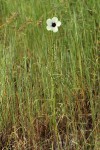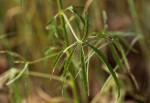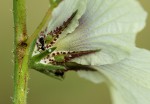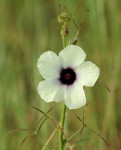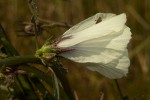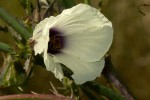Hibiscus cannabinus
Selected images: Click on each image to see a larger version and details of the record View all images (20)
Detailed records: Display species records QDS maps by: Google Maps Point records by Google Maps
Species details: Click on each item to see an explanation of that item (Note: opens a new window)
| Synonyms: |
Hibiscus henriquesii P. Lima |
| Common names: | Decan hemp (English) Kenaf (English) Wild stockrose (English) |
| Frequency: | Common |
| Status: | Native |
| Description: |
Annual, usually unbranched, herb to 2 m. Stems aculeate with small, rather sparse, prickles usually pointing upwards, otherwise nearly glabrous or with a longitudinal line of crisped pubescence. Leaves: petiole up to 22 cm; lamina up to 15 × 15 cm, usually subcircular in outline, 3-7-palmately lobed, the segments usually narrowly elliptic to linear (occasionally broader), scaberulous or almost glabrous with a few minute prickles on the nerves, usually with a prominent gland on the under surface near the base of the midrib; margin serrate or dentate. Flowers up to 10 cm in diameter, white, greyish or pale yellow, with dark purple centre. Epicalyx of 7-8 bracts; each up to 18 mm, linear. Calyx up to 25 mm, setose, 10-nerved; lobes acuminate or long-acuminate; gland on midrib of calyx lobe conspicuous, usually at least 1.5 mm in diameter (rarely 0). Capsule up to 20 × 15 mm. Seeds minutely faveolate. |
| Type location: |
Probably of Indian origin |
| Notes: | Somewhat similar to Hibiscus nigricaulis and differing in the characters highlighted in the description. |
| Derivation of specific name: | |
| Habitat: | A weed of disturbed and arable places |
| Altitude range: (metres) | |
| Flowering time: | Nov - Apr |
| Worldwide distribution: | Widespread in the tropics and subtropics |
| FZ divisions: | N,Z,T,MS,GI,M |
| Growth form(s): | Annual. |
| Endemic status: | |
| Red data list status: | |
| Insects associated with this species: | |
| Spot characters: | Display spot characters for this species |
| Images last updated: | Wednesday 29 June 2016 |
| Literature: |
Bandeira, S., Bolnick, D. & Barbosa, F. (2007). Wild Flowers of Southern Mozambique Universidade Eduardo Mondlane, Maputo, Mozambique Page 105. (Includes a picture). Baumann, G. (2005). Photographic Guide to Wildflowers of Malawi Wildlife and Environmental Society of Malawi Pages 96 - 97. (Includes a picture). Burrows, J.E. & Willis, C.K. (eds) (2005). Plants of the Nyika Plateau Southern African Botanical Diversity Network Report No. 31 SABONET, Pretoria Page 203. (Includes a picture). Chapano, C. & Mugarisanwa, N.H. (2003). Plants of the Matobo District National Herbarium and Botanic Garden, Zimbabwe Page 20. As Hibiscus asper Exell, A.W. (1961). Malvaceae Flora Zambesiaca 1(2) Pages 442 - 443. Heath, A. & Heath, R. (2009). Field Guide to the Plants of Northern Botswana including the Okavango Delta Kew Publishing Page 282. (Includes a picture). Kirby, G. (2013). Wild Flowers of Southeast Botswana Struik Nature, Cape Town South Africa Page 200. (Includes a picture). Mapaura, A. & Timberlake, J. (eds) (2004). A checklist of Zimbabwean vascular plants Southern African Botanical Diversity Network Report No. 33 Sabonet, Pretoria and Harare Page 60. Ntore, S. & al. (2024). Checklist of the vascular plants of Burundi Page 157. Pickering, H. & Roe, E. (2009). Wild Flowers of the Victoria Falls Area Helen Pickering, London Page 80. (Includes a picture). Setshogo, M.P. (2005). Preliminary checklist of the plants of Botswana. Sabonet Report no. 37. Sabonet, Pretoria and Gaborone Page 84. Siebert, S. & Mössmer, M. (Editors) (2002). SABONET Southern Mozambique Expedition 2001; Provisional Plant Checklist of the Maputo Elephant Reserve (MER) and Licuati Forest Reserve (LFR) SABONET News 7(1) Page 27. Timberlake, J.R. & Childes, S.L. (2004). Biodiversity of the Four Corners Area: Technical Reviews Volume Two (Chapter 5-15) Appendix 5-1: Plant Checklist Occasional Publications in Biodiversity 15 Page 218. Wild, H. (1955). Common Rhodesian Weeds Government of Rhodesia, Salisbury Page 41. (Includes a picture). |
Other sources of information about Hibiscus cannabinus:
Our websites:
Flora of Botswana: Hibiscus cannabinusFlora of Burundi: Hibiscus cannabinus
Flora of Caprivi: Hibiscus cannabinus
Flora of Malawi: Hibiscus cannabinus
Flora of Zambia: Hibiscus cannabinus
Flora of Zimbabwe: Hibiscus cannabinus
External websites:
African Plants: A Photo Guide (Senckenberg): Hibiscus cannabinusAfrican Plant Database: Hibiscus cannabinus
BHL (Biodiversity Heritage Library): Hibiscus cannabinus
EOL (Encyclopedia of Life): Hibiscus cannabinus
GBIF (Global Biodiversity Information Facility): Hibiscus cannabinus
Google: Web - Images - Scholar
iNaturalist: Hibiscus cannabinus
IPNI (International Plant Names Index): Hibiscus cannabinus
JSTOR Plant Science: Hibiscus cannabinus
Mansfeld World Database of Agricultural and Horticultural Crops: Hibiscus cannabinus
Plants of the World Online: Hibiscus cannabinus
Tropicos: Hibiscus cannabinus
Wikipedia: Hibiscus cannabinus
